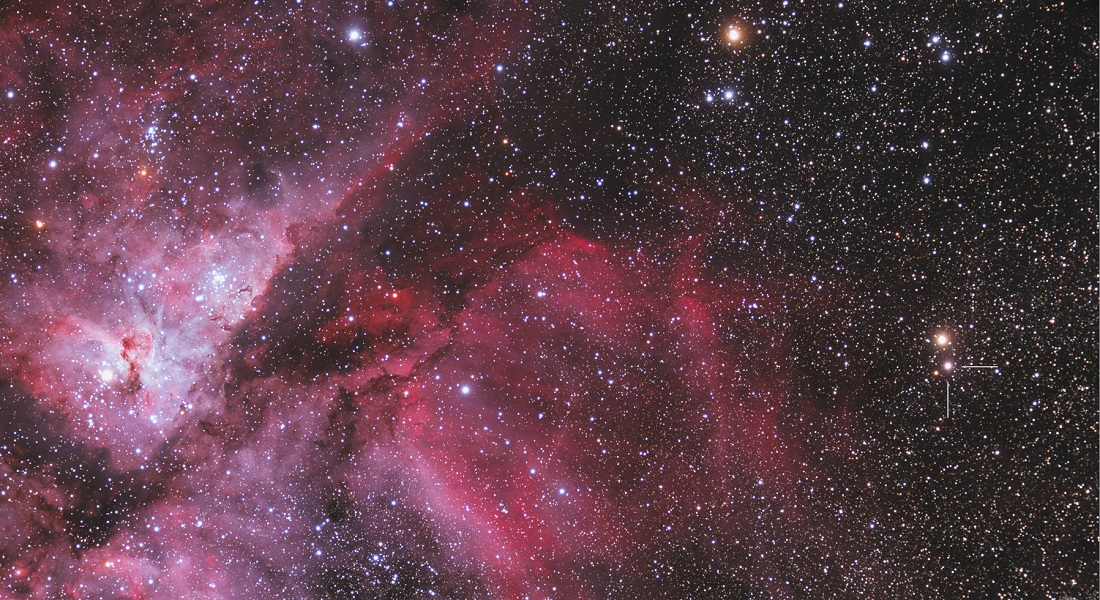Astronomical discovery: How novae light up the sky
Astronomers have long believed that the bright light of novae comes from thermo-nuclear explosions. Now, an international team, including researchers from the University of Copenhagen, has for the first time demonstrated that most of their brightness comes from shockwaves created in a unique and a previously unknown process. The finding ends a decades-old understanding of novae — and may help solve one of the greatest riddles in astrophysics.

Classical novae have been among the most extensively studied astrophysical phenomena since humans first began wondering about twinkling points in the night sky. Yet we continue to learn new things, as evidenced by new research conducted by the University of Copenhagen, among others.
Novae are explosions that occur when a white dwarf star and its companion star in a binary system orbit closer and closer around one another. As the two stars approach, gas from the companion star is stripped away and onto the white dwarf's surface, where it builds up like a gas shell. Eventually, after thousands of years, the piled up gas shell explodes in a nuclear fusion reaction.
For decades, astronomers believed that this thermo-nuclear explosive event is what caused white dwarves to suddenly shine up to a million times brighter — making them appear to be entirely new stars. Hence the name 'nova', meaning 'new' in Latin. But now, for the first time, an international team of researchers has demonstrated that it is the "shock", not the explosion itself, which mainly causes a nova to blaze brightly in the night sky.
"It's a whole new understanding of how a nova works. Indeed, it changes the more than 45-year-old perception that novae only get their light from the nuclear reaction," states Luca Izzo, co-author of the study — now published in Nature Astronomy. Izzo is an astrophysicist and post-doctoral fellow at the University of Copenhagen’s Niels Bohr Institute.
The new evidence comes from observations of 'V906 Carina', a nova discovered in 2018 roughly 13,000 light-years from Earth.
What is a 'shock'?
What are shocks in this context, and where do they come from? The astronomers’ new discovery is that material from a white dwarf is ejected during at least two, and perhaps multiple, distinct phases and at different speeds, where it was previously thought to be the result of a single event: the aforementioned nuclear reaction. As ejected material collides, shock waves are created that heat up the material to produce the majority of a nova's bright light.
"It's similar to when a fighter jet breaks the sound barrier and creates a shock that triggers a supersonic bang. In a nova explosion, the shock creates light instead of sound," explains Luca Izzo.
How did they do it?
Another side effect of the astronomical shocks detected by the researchers were gamma rays produced as a by-product. By comparing gamma radiation and optical light from the nova using NASA’s Fermi satellite and BRITE, an optical satellite, they were surprised to see that whenever there was a fluctuation in gamma rays, there was a correspondent fluctuation in optical light from the nova.
"The simultaneous fluctuations in optical and gamma ray brightness mean that both things must come from the same source - namely, the shock waves. During the fluctuations, the nova glowed twice as brightly, indicating that the shocks were indeed responsible for most of the brightness created by the nova explosion," says Luca Izzo.
The researchers do not yet know the exact mechanism behind the explosion. Furthermore, they still do not know why the nova emits at least two different components of material, or where the other component comes from. They hope that the dataset will shed further light upon further analysis.
The study could also be an important step towards solving one of the greatest riddles of astrophysics:
"If we can understand where nova emissions come from, we may also be able to find the definitive answer to whether ordinary novae are the ancestors of type1a supernovae, which is a popular theory and one of the most important and current questions in astrophysics. Type-1a supernovae are used to determine distances in the universe, so this could make it easier to learn more about the history of the universe as a whole," concludes Luca Izzo.
About novae
-
A single nova explosion emits between 10,000-100,000 times more energy than our Sun does during an entire year.
-
About 10-12 novas are detected annually in the Milky Way.
-
Both novae and supernovae release huge amounts of energy and light. Whereas the more powerful explosions of supernovae destroy their host stars, white dwarves survive novae explosions and return to their normal states after a few weeks or months.
Contact
Luca Izzo
Post-doctoral fellow
Niels Bohr Institute / DARK
University of Copenhagen
+45 35 33 71 53
luca.izzo@nbi.ku.dk
Maria Hornbek
Journalist
Faculty of Science
University of Copenhagen
+45 22 95 42 83
maho@science.ku.dk
